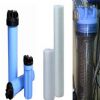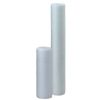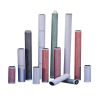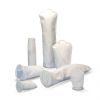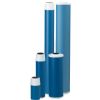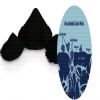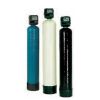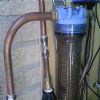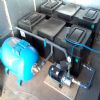Specialist filtration
WRAS approved filters
Water treatment specialists
Sediment control
Advice on sizing and specification
Water filters and housings/ Sediment removal
Filtration systems and settlement tanks are effective ways of removing sediment and physical contaminants from your water supply. Our most common application for filtration is to remove sediment from the water to provide a clear sample of water for an ultraviolet unit to treat.
- FWT supply and install a large variety of water filters and filter housings
- All our stock filters and housings are WRAS approved for use with potable water systems
- The filter cartridge is placed inside a filter housing through which the water passes
- We will help you select a suitable type and size of filter to meet your requirements
- We generally specify industrial filter housings which are more robust
- For commercial applications or bottling plants we are able to specify stainless steel or food-grade housings and these can accommodate a number of cartridges.
The filter type and size is dependent on the required flow rate and quantity of sediment in the water, filters are generally sized in 10” increments and come in 2 different diameters a ‘standard’ 2.5” diameter and a larger 4.5” diameter. For depth filtration as a rule of thumb FWT generally recommend approximately 10” of filtration for every 15 litres/min of flow.
Types of filters and sediment removal
Unlike many companies in the market we only supply WRAS approved filter cartridges for standard sediment removal to ensure compliance with the private water regulations.
Spun filter cartridge
The spun range resemble long reels of compressed cotton wool and are a cost effective way of removing fine sediment from the water. Our filters offer the essential WRAS approval, dirt holding capacity and low cost. FWT generally install at least a 5-micron spun filter prior to an ultraviolet treatment unit to ensure a clear sample of water for the UV light to penetrate, available in standard and big blue diameters. Within the range of WRAS approved filters there are options including a silver-impregnated filter designed to offer additional anti-microbial protection or a standard spun cartridge.
Pleated filter cartridge
The pleated range offer an increased efficiency and a greater range of filtration sizes including finer filtration. Constructed of all-polypropylene materials encased in a ridged outer. Pleated filters are available in a range of efficiencies up to 100% efficient and micron ratings 0.003 – 100. Filters are generally not able to control bacteria in water but can remove cysts, such as Crytosporidium. Pleated filters are generally more expensive than spun filters and are available in standard and large diameters.
Bag filters
As their name implies, these filters consist of a bag inside a filter housing through which the water flows leaving the sediment behind. These filters are made of various synthetic fibres, such as polyester or polypropylene, and come in various shapes, sizes and micron ratings to suit many applications.
Bag filters allow large volumes of contaminated water to be filtered where a high flow rate and lower efficiency are needed. They require a large diameter bag housing.
Activated carbon filters
Activated carbon filters are effective in the removal of tastes and odours from water and for the reduction of chlorine. They also have the ability to reduce many organic compounds. Specially prepared activated carbon is selected for its efficient filtration capabilities from a variety of material sources. A large surface of available filtration area is achieved by the creation of many fine pores and channels in each of the carbon granules. Carbon filters are sometimes used as a polisher as part of a filtration cascade. Carbon filters are available for both standard and large diameter filter housings.
Turbidity treatment unit
If you need to remove large volumes of sediment, standard filter systems may not be the most efficient method. A back- washable filter system is capable of filtering out large quantities of sediment to a nominal 5 micron. It consists of a vertical chamber containing the media through which the water passes and the sediment is trapped, the media is then back washed at a pre-determined quantity of water or time to a drain. A standard sediment removal filter is usually recommended after the media unit if the water is used for human consumption.
Settlement tanks
A water storage tank can be used to store water before use and carry out the settlement process if large quantities of sediment are to be removed. Our engineers will ensure the correct configuration of pipe work to cater for the build-up of sediment and to avoid turbulence. Regular inspection of the system is required to ensure the system continues to work effectively; after a period of time the tank will require cleaning to remove the build-up of sediment.
Sand filters
These generally consist of a column of sand through which the water is passed. Different grades of sand can be used depending on the quantity of sediment to be removed. Sand filters are useful where there is a lot of sediment in the water and where there is insufficient time to allow for settlement, as is the case for high volume spring or borehole supplies, swimming pools or irrigation systems. They are usually used as a pre-filter in conjunction with other types of filtration and need to be regularly backwashed to remove the sediment build up; they are not effective at removing fine sediment.
| Further information is available | ||
|
|
|
| Related images in this section Click for a larger image and description |
|
|


